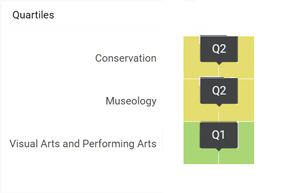Forget, not to remember: the black heritage invisibilized in the legally protected center of Laguna, Brazil
Abstract
This work has the objective to study the status of the built patrimony preservation, with a main focus on the black culture, participant in the history of Laguna (portuguese territory, lócus of the Treaty of Tordesillas and the third oldest city of the State of Santa Catarina, in Brasil). It is considered the hipothesys that the positive historic discourse that praises the white, portuguese Christian, has based the actions of preservation of Laguna’s patrimony, ignoring and despising other peoples: the hegemony of the legacy of portuguese christian descent leads to the invisibilization of legacies, mainly indigenous and black. The question arises: what constitutes the immovable patrimony of blacks in Laguna? The answer of this question calls upon historical research, including bibliographic and iconographic analysis, and the data survey in loco. Among the main preliminary conclusions, it was verified that the places of black presence at the protected central area are not recognized or appreciated, therefore, not preserved.
Downloads
References
ABREU, L. C. (2013). “Blog as mil e uma histórias de Laguna.” Laguna. https://asmileumahistoriaslaguna.blogspot.com/. [consulta: 29/3/2017].
ANDRADE, N. (2011). “Ampliações do conceito de patrimônio edificado no Brasil.” En Reconceituações contemporâneas do patrimônio, Gomes, M. A.; Corrêa, E. (orgs.). Salvador: EDUFBA, 145-170.
BANDEIRA, M. de L. (1990). “Terras negras.” En Terras e territórios de negros no Brasil, Leite, I. Florianópolis: UFSC, 7-23.
BENÍCIO, D. (2018). Laguna, arquitetura novecentista e preservação do patrimônio. 2018. Tese (Doutorado em Artes Visuais) - Udesc, Florianópolis.
BENÍCIO, D. et al. (2013). “Estudo das ações do Escritório Técnico do Iphan em Laguna/SC incidentes na área abrangida pela poligonal de tombamento desde 1985 a 2010.” En Arquimemória, Salvador: UFBA; IAB-BA.
BRASIL (1953). Ministério da Educação e Cultura. Secretaria da Cultura. Subsecretaria do Serviço do Patrimônio Histórico e Artístico Nacional. “Processo 0492-T-53.” Rio de Janeiro: Sphan. http://acervodigital.iphan.gov.br/xmlui/handle/123456789/4709?discover?rpp=10&etal=0&query=laguna#page/1/mode/1up. [consulta: 6/7/2016].
BRASIL (1984). Ministério da Educação e Cultura. Secretaria da Cultura. Subsecretaria do Serviço do Patrimônio Histórico e Artístico Nacional. “Processo 1122-T-84.” Rio de Janeiro: Sphan. http://acervodigital.iphan.gov.br/xmlui/handle/123456789/4800?discover?rpp=10&etal=0&query= laguna#page/1/ mode/1up. [consulta: 6/7/2016].
BRASIL (1937). Presidência da República. “Decreto-lei federal n. 25, de 30 de novembro de 1937.” http://www.planalto.gov.br/ccivil_03/decreto-lei/del0025.htm. [consulta: 28/6/ 2015].
BRASIL (1988). Presidência da República. “Constituição da República Federativa do Brasil de 1988”. Brasília: Planalto. http://www.planalto.gov.br/ccivil_03/Constituicao/Constituicao.htm. [consulta: 28/6/ 2015].
CASTRIOTA, L. (2009). Patrimônio cultural. Belo Horizonte: IEDS; São Paulo: Annablume.
CHAGAS, M. (2002). “Memória e poder”, Cadernos de Sociomuseologia, 19: 43-81. https://revistas.ulusofona.pt/index.php/cadernosociomuseologia/article/view/367. [consulta: 18/11/2020].
FONSECA, M. C. (1997). “O patrimônio em processo.” Rio de Janeiro: UFRJ; Iphan.
INSTITUTO BRASILEIRO DE GEOGRAFIA E ESTATÍSTICA (IBGE) (2017). “Catálogo.” Rio de Janeiro: IBGE. http://biblioteca.ibge.gov.br/ index.php/biblioteca-catalogo?acervo=todos&campo=todos¬qry=&opeqry= &texto=Laguna&digital=false&fraseexata=. [consulta: 29/03/2017].
LAGUNA (1977). Prefeitura Municipal de Laguna. “Lei n. 34, de 03 de novembro de 1977.” Laguna: PML. https://leismunicipais.com.br/pdf/Lei-ordinaria-34-1977-Laguna-SC-consolidada-[29-04-1996].pdf. [consulta: 18/11/2020].
LAGUNA (1978). Prefeitura Municipal de Laguna. “Plano de restauração e utilização social e econômica do patrimônio cultural, histórico, artístico, paisagístico e arquitetônico da Laguna.” Laguna: PML.
PASSOS, A. (2015). “Rotas internas do comércio de escravos.” 2015. Trabalho de Conclusão de Curso (Bacharelado em História) - UFSC, Florianópolis.
PESSOA, J. (2000). “Em tudo semelhante, em nada parecido.” Oceanus, Lisboa, 41: 71-81.
QUIJANO, A (2014). “Estado-nación, ciudadanía y democracia.” En Cuestiones y horizontes, Quijano, A. Buenos Aires: Clacso, 605-624.
QUINTERO, P.; FIGUEIRA, P.; ELIZALDE, P. (2019). “Uma breve história dos estudos decoloniais.” São Paulo: MASP; Afterall. https://masp.org.br/uploads/temp/temp-QE1LhobgtE4MbKZhc8Jv.pdf. [consulta: 18/11/2020].
ROSA, J. C. (2019). “Sociabilidades e territorialidade.” Curitiba: CRV.
SANT’ANNA, M. (1995). “Da cidade-monumento à cidade-documento.” 1995. Dissertação (Mestrado em Arquitetura e Urbanismo) - UFBA, Salvador.
ULYSSÉA, N. (1976). “Três séculos na Matriz de Santo Antônio dos Anjos da Laguna.” En Santo Antônio dos Anjos da Laguna, Cabral, O. (coord.). Florianópolis: IOESC, 159-200.
ULYSSÉA, S. (1943). A Laguna de 1880. Florianópolis: IOESC.
ULYSSÉA, R. (org.) (1956). Publicação comemorativa do centenário da Comarca da Laguna. Porto Alegre: Santa Terezinha.
ULYSSÉA, R. (2004). Laguna: memória histórica. Brasília: Letra Ativa.
VARINE, H. (1979). “Entrevista.” En Os museus no mundo, Rojas, R. (org.). Rio de Janeiro: Salvat, 7-21, 70-81.
- Copyright and intellectual property belongs to author. Author guarantees editing and publishing rights to Ge-Conservación Journal, under a Creative Commons Attribution License. This license allows others to share the work with authorship and the original source of publication acknowledgement.
- Articles can be used for scientific and educational purposes but never for commercial use, being sanctioned by law.
- The whole content of the article is author’s responsibility.
- Ge-Conservación Journal and authors may establish additional agreements for non-exclusive distribution of the work version published at the Journal (for example, on institutional repositories or on a book) with acknowledgment of the original publication on this Journal.
- Author is allowed and encouraged to disseminate his works electronically (for example, on institutional repositories or on its own website) after being published on Ge-Conservación Journal. This will contribute for fruitful interchanges as also for wider and earlier citations of the author’s works.
- Author’s personal data will only be used for the Journal purposes and will not be given to others.









